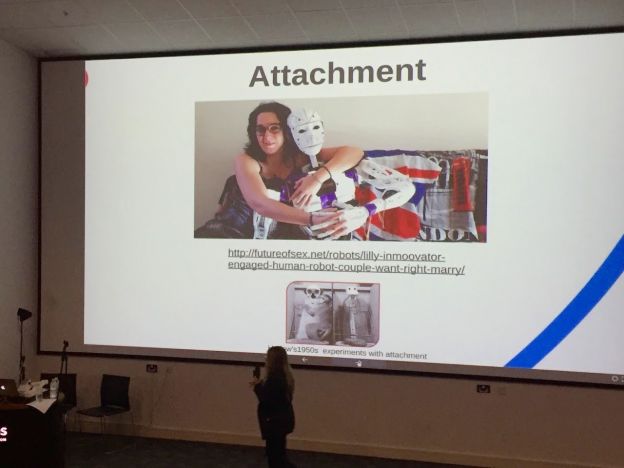
http://www.playboy.com/articles/the-future-of-sex-is-the-internet-of-bodies

We’re experiencing a huge surge of interest in the field of Human-Robot interaction, reflected not only in the news but in the barrage of cyborg-themed films and TV shows filling our screens. What they all have in common—from Westworld to Humans, Ex Machina to the highly anticipated Blade Runner sequel—is a fixation on what our relationship with machines will look (and feel) like in a future that is both dystopian and titillating.
So it was no real surprise that the Second International Congress on Love and Sex With Robots, held last December at the University of London, attracted a lot of attention. With the adult entertainment industry already evolving virtual reality much more quickly than it evolved streaming video or webcams, and advances in fields like Natural Language Processing (NPL), we are getting much closer to the point where artificial intelligence will be able to pass the Turing Test and become effectively indistinguishable from human intelligence. We might have once laughed at the concept of Woody Allen’s Orgasmatron, but sex with robots is pretty much a foregone conclusion—and it will probably happen much sooner than experts previously thought.
In fact, David Levy says that when he first wrote the book that eventually inspired the conference, he predicted that the first human-robot marriages would occur by 2050. When asked the same question at the conference, he told the audience it is entirely possible this will happen much sooner.
Among the philosophical discussions, there was also opportunity to showcase some eye-catching gadgets. There was the Teletongue, a pair of ear-shaped lollipops developed by researchers at Keio University in Japan, programmed to react to each other based on the users’ licking sounds and movements. There was also a device named Kissenger, which connected two mobile phones for a “Real-time Internet Kiss Communication Interface.” Its creator, Emma Yann Zhang, explained that such haptic devices were actually very effective in conveying feelings and emotions and helping to evoke a sense of presence in a remote environment. According to her, the importance of physical interaction to the quality of our relationships is still grossly underestimated.
This is something that Ghislaine Boddington has been researching for over 20 years. She believes that so-called “body technologies” have enormous potential to connect people romantically, emotionally, physically and sexually through devices that blend with our physical selves. She coined the term “Internet of bodies” to describe the way that such devices will eventually enable us to network our responses, giving a whole new meaning to “keeping in touch.”
“Physical intimacy goes way beyond sex, or even romance,” she explains. “It’s rather about attachment, and this includes how we feel about each other, our environment and all the objects that surround us. What excites me now is actually the convergence of these technologies and bringing them into our bodies to create new types of intimacy and hyper-enhanced sensualities.”
We already live in a world where technology is so embedded in our lives that most of us don’t realize how often we check our phones. But the next logical steps in that relentless integration between mind, body and tech might see us do away with those artificial interfaces altogether. We would, quite literally, embody out technology.
Read on for a few technologies that could bring about this sensual revolution.
FROM WEARABLES TO IMPLANTS
Boddington believes that our quest to augment our existence and indulge in new experiences will lead us to turn our bodies into “digital interaction canvas.” Our relationship with technology has already become much more intimate since the widespread adoption of devices like the FitBit, which monitor a broad range of physical data, but wearing such devices around the clock can have its drawbacks. The next generation of wearables is likely to be much less cumbersome and intrusive, such as DuoSkin tattoos made from gold leaf. They’re not only quite beautiful; they’re easily customizable to a variety of designs and can be used to control a variety of mobile devices. “Through the user-friendly fabrication process, we enable people to design and create their own skin technology,” explains Cindy Hsin-Liu Kao, the MIT researcher leading the project. The transfers communicate using NFC tags made from chips connected to coils and are surprisingly hard-wearing, comfortable and inexpensive.

The next logical step, then, would be for implants to become increasingly accepted, and we’re already much further along that path than you might think. When Donna Haraway published her seminal Cyborg Manifesto back in the 1990s, she pointed to many kinds of common implants. That number has gone up dramatically since then, ranging from tooth and breast implants to pacemakers and devices that provide deep brain stimulation to Parkinson sufferers. Tiny implants in your hand can already replace accessories like a payment card or key fob, and we will see this become a lot more pervasive in years to come.
“There are probably over 200 kinds of implants around at the moment,” says Boddington, “and these are all very programmable. So as these become increasingly integrated into our lives and less of a taboo, we’re potentially looking at a sort of ‘body hacking’ scenario that takes us beyond this traditional—and rather artificial—mind-body separation.”
PROGRAMMABLE GELS
One rather mind-blowing possibility is that of embedding nanotechnology in gels, which could be used to stimulate our erogenous zones. This type of technology effectively means that microscopic robots within the gels can be programmed to collect data from our body and react to it according to our preferences.
Boddington makes clear that this type of application is still speculative, but the technology itself already exists and is being used (no pun intended) to lubricate robot joints.
“There’s nothing to stop us developing this into gels we could apply to our erogenous zones,” she explains. “These could provide straightforward tactile stimulation, or help you sync your reactions to that of your partner.” We could even be looking at scenarios where data from your body could be used to personalize virtual reality content in real time to fulfill needs and fantasies you didn’t even know—or admit—you had.
VIRTUAL PRESENCE
Advances in virtual reality will help us create a sense of “hyper-presence” which will allow us to project ourselves into virtual worlds in unprecedented ways, according to Boddington. That might be hard to imagine in the context of the cartoon-like avatars we see in most VR platforms these days, but advances in technologies such as morphing, sampling and 3D-scanning will soon allow us to create much more personalized avatars capable of conveying emotion.
The importance of realistic movement is something that she’s very aware of, coming from a dance and performing arts background: “The intimate interplay between body language and presence is a key part to enabling a sense of full immersion in VR,” she explains. “Touch, caress gaze, it all feeds into it. The way your skin brushes against another, the feel of a heartbeat or the sound of someone’s breath. Over the next 10-15 years, we will see a convergence of these technologies with things like virtual and even mixed Reality holograms to enable ways for us to meet each other and be intimate in new ways, whether you’re in the same room or over distance.”
The most exciting possibilities of the next decade are therefore not in creating autonomous machines to be become our proxy lovers, but in incorporating those machines into our own bodies, creating a true symbiosis between our “real” and “virtual” identities. When the wealth of data collected by these embedded devices is leveraged to connect our bodies both to our fellow humans and to other machines, it will open up an entirely new array of possibilities. It could forever change how we relate to our physical selves. Pleasure, sexual and otherwise, would no longer be tethered to any particular space and time; It would live within us.




